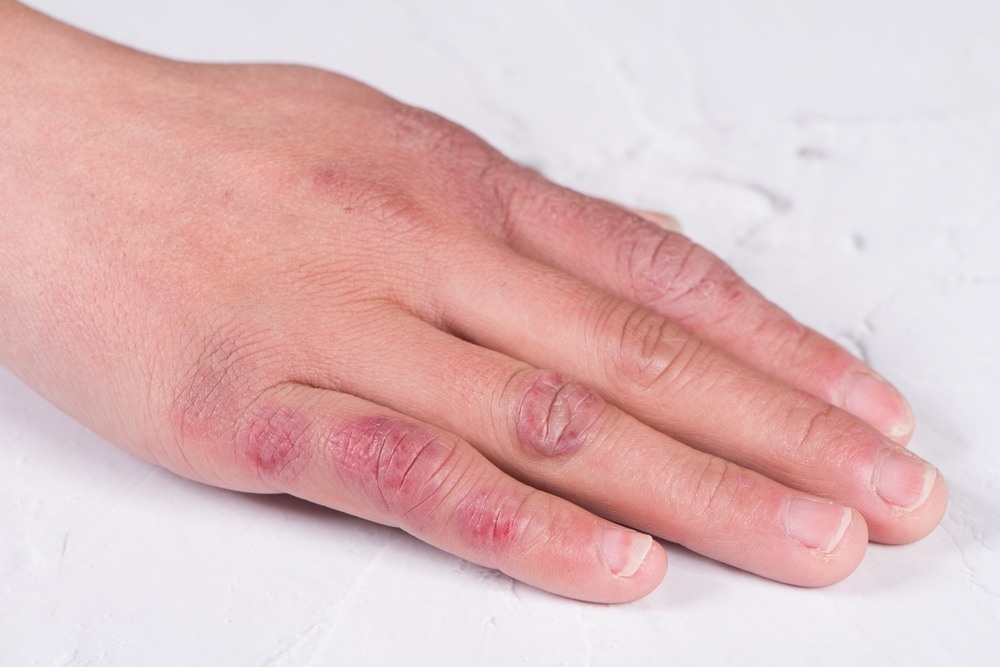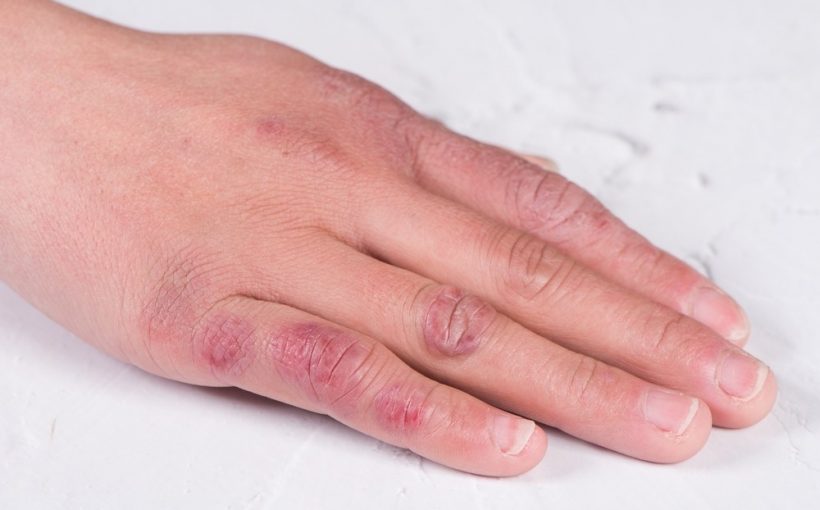A recent PLoS Global Public Health journal study discusses the associations between chilblains and coronavirus disease 2019 (COVID-19).

Study: COVID-toes: An ecological study of chilblains and COVID-19 diagnoses in Victoria, Australia. Image Credit: lungfu01 / Shutterstock.com
Background
The COVID-19 pandemic has caused global public health and economic disruptions. In addition to the typical respiratory symptoms, some COVID-19 patients experience cutaneous manifestations, particularly chilblains.
Chilblains, an inflammatory dermatologic condition, can affect the body's acral regions and frequently occurs in middle-aged adults and women. Previously, chilblains were not considered to be associated with infections until the COVID-19 pandemic.
One study reported that 45% of individuals with skin eruptions had COVID-19-like respiratory symptoms, while other studies have not found serologic evidence of COVID-19 in those with chilblains.
Chilblains have been concomitantly reported with COVID-19 in a Californian epidemiologic study and numerous European case series. However, the mechanisms of chilblain in COVID-19 remain unknown.
One systematic review concluded that increased expression of the angiotensin-converting enzyme 2 (ACE2) receptor utilized by the severe acute respiratory syndrome coronavirus 2 (SARS-CoV-2) to gain entry into host cells in the skin might cause cutaneous manifestations of COVID-19.
A skin biopsy is needed to confirm the chilblain diagnosis histologically; however, there is a lack of consensus on whether chilblains in COVID-19 share similar histological characteristics as idiopathic chilblains.
About the study
In the present study, researchers assess the temporal association of chilblains with COVID-19 in an ecologic framework. Data were obtained from the population-level analytics and reporting (POLAR) system. Primary health networks (PHNs) in Eastern Victoria contributed to this study with over 500 general practices (GPs) and a catchment of more than three million patients.
Data for this study were processed according to POLAR's data de-identification decision-making framework. The authors conducted the retrospective cohort analysis between January 2017 and September 2021, in which inclusion criteria were diagnoses of chilblain, COVID-19, or suspected COVID-19 in any Victorian GP.
Patients' ages and the date of diagnosis were extracted and de-identified. Data on local minimum temperature were obtained from the Bureau of Meteorology and aggregated to yield average minimum temperature data. A zero-inflated negative binomial (ZINB) regression was performed for data modeling.
A multivariable model was created using diagnoses of COVID-19 and suspected COVID-19 and weekly minimum temperature to predict chilblains. Additionally, lead and lag models were generated for the data to examine possible lags in the association between COVID-19 and chilblains. Finally, the relationship between chilblains and COVID-19 was evaluated across age groups, including those between 0-16, 17-49, and over 50.
Study findings
A total of 6,846 chilblain diagnoses were reported from January 2017 to September 2021 across the three PHNs. Chilblain distribution across the age groups was similar to that of the general population in Victoria. Moreover, 3,687 COVID-19 diagnoses and 4,688 suspected COVID-19 diagnoses occurred in the same period.
The median, minimum temperature was 8.12 °C in Victoria. The maximum and minimum temperatures remained consistent each year; however, the maximum temperature was slightly lower in 2021, likely due to the end of data collection in September. Chilblain presentations peaked every winter, coinciding with the falling temperature throughout the study.
COVID-19 and suspected COVID-19 diagnoses followed the peak in chilblain diagnoses in 2020 but lagged in 2021. There was a significant association between chilblains and temperature decrease, with a risk ratio of 1.33 per 1°C.
When the 95th percentile of the diagnoses of COVID-19 and suspected COVID-19 was compared to the 50th percentile, the risk ratios of chilblains were 5.72 and 3.23, respectively.
Additionally, a secondary model generated using temperature as the predictor of chilblains yielded a risk ratio of 1.37 per 1 °C. However, this model was inferior to that using the diagnoses of COVID-19 as covariates.
In analyses using lead and lag models, there was no meaningful relationship between COVID-19 and chilblains in GP settings. A stronger association of COVID-19 and suspected COVID-19 with chilblains was noted in those between 0-16.
Conclusions
The authors found an increase in chilblain diagnoses in the participating PHNs, which might be significantly correlated with the circulation of COVID-19 in Victoria. Using temperature alone for modeling was insufficient to predict chilblains; thus, the diagnoses of COVID-19 were necessary to explain the surge in chilblains throughout the COVID-19 pandemic.
In summary, the study demonstrated a significant relationship between chilblains and COVID-19 in Victorian GPs in the first two years of the COVID-19 pandemic. These findings emphasize the potential of using primary care data to increase clinician awareness of the potential for chilblains in COVID-19 patients.
- Sawires, R., Pearce, C., Fahey, M., et al. (2022). COVID-toes: An ecological study of chilblains and COVID-19 diagnoses in Victoria, Australia. PLOS Glob Public Health. doi:10.1371/journal.pgph.0000488
Posted in: Medical Research News | Medical Condition News | Disease/Infection News
Tags: ACE2, Angiotensin, Angiotensin-Converting Enzyme 2, Biopsy, Chilblains, Coronavirus, Coronavirus Disease COVID-19, Enzyme, Pandemic, Primary Care, Public Health, Receptor, Respiratory, SARS, SARS-CoV-2, Severe Acute Respiratory, Severe Acute Respiratory Syndrome, Skin, Syndrome

Written by
Tarun Sai Lomte
Tarun is a writer based in Hyderabad, India. He has a Master’s degree in Biotechnology from the University of Hyderabad and is enthusiastic about scientific research. He enjoys reading research papers and literature reviews and is passionate about writing.
Source: Read Full Article
